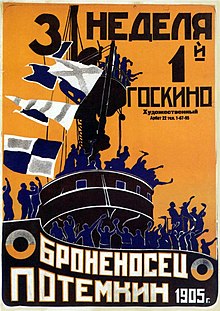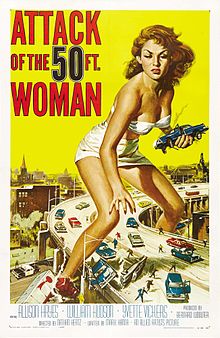Film poster
They began as outside placards listing the programme of (short) films to be shown inside the hall or movie theater.[4][5][6] After the National Screen Service ceased most of its printing and distribution operations in 1985, some of the posters which they had stored in warehouses around the United States ended up in the hands of private collectors and dealers.[12][13][6] Ghanaian hand-painted movie posters from the tradition's Golden Age in the 1980s and 1990s have sold for tens of thousands of dollars and been exhibited in galleries and museums across the world.However, most modern posters are produced in large quantities and often become available for purchase by collectors indirectly through various secondary markets such as eBay.Films released by major production companies experiencing financial difficulties often lacked lobby sets, such as Manhunter (1986).These, however, also refer to black-and-white press photographs, in addition to the more typical 8-by-10-inch promotional devices resembling lobby cards.The Beinecke Rare Book and Manuscript Library at Yale University holds a collection of lobby cards from silent western films that date between 1910 and 1930.[31] A billing block can be seen at the bottom of Reynold Brown's poster from Attack of the 50 Foot Woman (1958), which is reproduced below.[32] By convention, the point size of the billing block is 25 or 35 percent of the average height of each letter in the title logo.The Hollywood Reporter defines the term "key art" as "the singular, iconographic image that is the foundation upon which a movie's marketing campaign is built.








This Gun for Hirepostertaglinemovie theaterspressbookillustrationsL'Arroseur arroséLumière brothersRudolph ValentinoBlood and SandLumiere BrothersUnited StatesNational Screen Servicefilm studiosBattleship PotemkinBollywoodHunterwaliFearless NadiaBruce HershensonChristie'sFritz LangMetropolisThe MummySotheby'sBride of FrankensteinThe Black CatHeritage AuctionsDraculaBombayPulp FictionLucky StrikeMary PickfordLittle Lord FauntleroyThe Running ManThe Italian JobManhunterblack-and-whiteBeinecke Rare Book and Manuscript LibraryYale Universitysilentwesternensemble castOne sheetBus stoplandscape formatbillboardExposition Universelle (1889)DaybillGodzillaBilling (filmmaking)typefacepoint sizeAttack of the 50 Foot WomanReynold BrownJohn AlvinBlade RunnerThe Lion KingE.T. the Extra-TerrestrialRichard AmselThe StingRaiders of the Lost ArkSaul BassLove in the AfternoonVertigoThe ShiningCreature from the Black LagoonThe Incredible Shrinking ManThe Time MachineRenato CasaroConan the BarbarianNever Say Never AgainGhost ChaseTom ChantrellVon Ryan's ExpressZulu DawnThe Land That Time ForgotJack DavisIt's a Mad, Mad, Mad, Mad WorldViva Max!Kelly's HeroesVic FairVampire CircusConfessions of a Driving InstructorThe Man Who Fell to EarthFrank FrazettaWhat's New Pussycat?Bill GoldCasablancaA Clockwork OrangeFor Your Eyes OnlyBoris GrinssonThe 400 BlowsKaroly GroszFrankensteinThe Invisible ManAl HirschfeldThe Wizard of OzThe Sunshine BoysMitchell HooksDr. NoThe Sand PebblesEl DoradoThe Brothers HildebrandtBarbarellaTom JungStar WarsThe Empire Strikes BackPapillonThe Lord of the RingsGone with the WindMort KünstlerThe Poseidon AdventureThe Taking of Pelham One Two ThreeThe HindenburgFrank McCarthyThe Ten CommandmentsThunderballThe Dirty DozenOn Her Majesty's Secret ServiceRobert McGinnisBreakfast at Tiffany'sCasino RoyaleDiamonds Are ForeverNoriyoshi OhraiBob PeakOur Man Flint